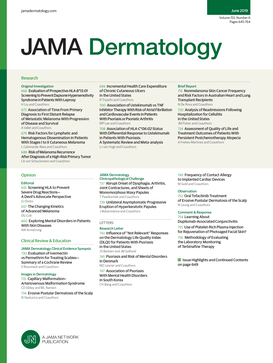Key Points
Question Which are the possible cutaneous and serological markers that can be used to predict the development of atopic dermatitis (AD) in infants?
Findings In this observational study, serum biomarkers, transepidermal water loss, and hydration rate of 40 infants were evaluated. There were statistically significant higher CCL17 and IL-31 cord blood serum levels in the infants who developed AD, and anterior cubital fossa transepidermal water loss values at 1, 6, and 12 months of age were also considerably higher in infants who developed AD.
Meaning AD is a chronic skin disease for which some identifiable cutaneous or serological markers may be capable of predicting its development.
Abstract
Importance Atopic dermatitis (AD) is the most prevalent chronic skin condition characterized by inflammation and itching. Currently, there is no reliable method for identifying which newborns might have an increased risk of developing AD.
Objective To evaluate the predictive value of serological biomarkers, such as CCL17/thymus- and activation-regulated chemokine, CCL18, CCL22, CCL27, IL-31, and thymus stromal lymphopoietin, with transepidermal water loss (TEWL) and hydration rate and the development of AD in infants.
Design, Setting, and Participants This observational prospective study included 40 consecutive full-term newborns from a single university hospital in Pisa, Italy. The cutaneous markers of infants were assessed at 1, 6, and 12 months of age, while the biomarkers from the 10-mL sample of cord blood taken at birth were measured after delivery. Data were collected from March to December 2018 and analyzed from January to April 2019.
Main Outcomes and Measures Level of serological biomarkers associated with TEWL and hydration rate, as well as the emergence of AD during the first 12 months of life.
 |
| IL-31 and CCL17/Thymus- and Activation-Regulated Chemokine (TARC) Cord Blood Serum Values |
Conclusions and Relevance In this observational study, the analysis of TEWL at the anterior cubital fossa area occurred prior to and correlated with the clinical signs of AD. Quantification of cytokines indicated that assessing cord blood serum levels of CCL17 and IL-31 could offer new perspectives in identifying newborns who might be susceptible to AD. Larger studies are needed to validate these findings.

No comments:
Post a Comment